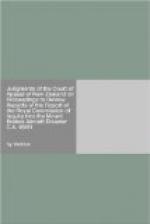In paragraph 229 it is said that submissions had been put to the Commissioner that “the shifting of the McMurdo waypoint was done deliberately so as to conform” with a track used by military aircraft proceeding to Williams Field. Then in paragraph 230 there is a summary of contrary arguments advanced by members of the navigation section to support their claim of accident. They include—
“(c) It was pointed out that if the McMurdo waypoint had been intentionally moved 25 miles to the west, then the flight plan would have a corresponding change to the track and distance information which it previously contained. Instead of a true heading from Cape Hallett to the NDB of 188.9 deg. and a distance of 337 nautical miles, there would have been required, in respect of the changed McMurdo waypoint, a true heading of 191 deg. and 343 nautical miles. Similar alterations would have had to be made in respect of a return journey to the true north.”
That is the matter already outlined. Concerning it the Commissioner said in paragraph 234 that there was “considerable validity in this point” although then he added:
“... the Navigation Section may have thought it not necessary to alter the track and distance criteria from Cape Hallett to McMurdo for the reason that the pilots were accustomed to flying on Heading Select down this sector and not by reference to the fixed heading programmed into the AINS.”
There is a further argument of the navigation section which is summarized in paragraph 230 (e)—
“It was submitted that an alteration to the McMurdo waypoint to facilitate better sightseeing was not valid because flight captains had a discretion to deviate horizontally from the flight plan track.”
The Commissioner accepted that point as “a valid objection” in answer to the suggestion that the move had been deliberate (paragraph 236).
However when he came in paragraph 255 (a) to express his final conclusion upon this general question he initially said this—
“The first question is whether the programming of the McMurdo waypoint into the ‘false’ position before the commencement of the 1978 flights was the result of accident or design. On balance, it seems likely that this transposition of the McMurdo waypoint was deliberate.”
There is reference at that point to a track and distance diagram indicating a track down McMurdo Sound, and the sub-paragraph then continues—
“So as I say, I think it likely that the change of the McMurdo destination point was intended and was designed by the Navigation Section to give aircraft a nav track for the final leg of the journey which would keep the aircraft well clear of high ground.”
Then the final portion of paragraph 255 (a) leaves the matter in the following half-way situation—




